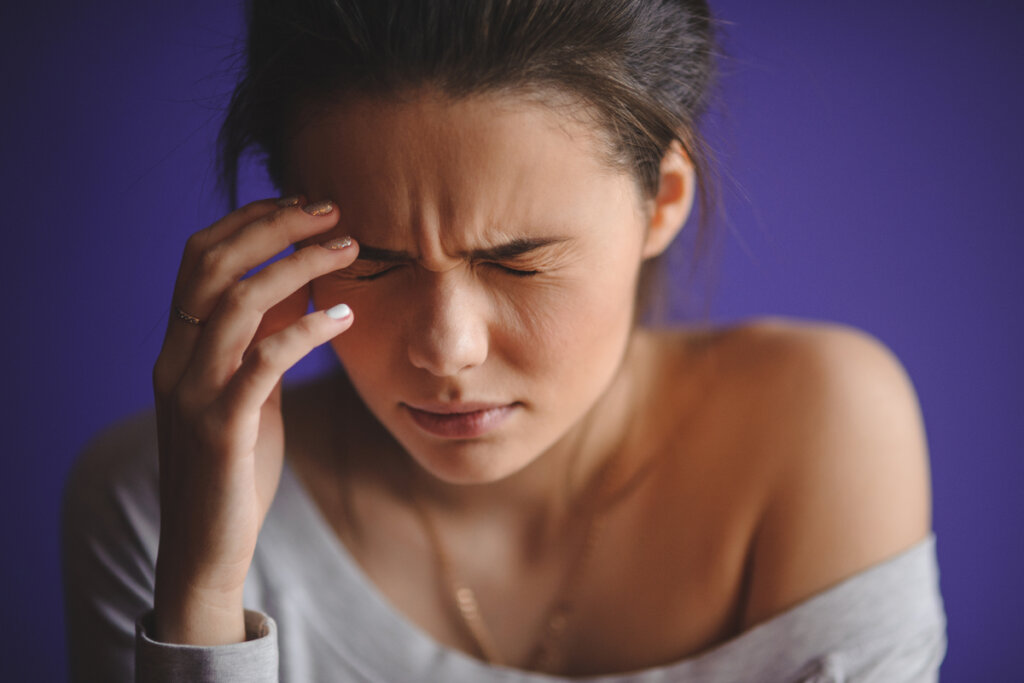Menstrual Migraine: An All Too Frequent and Silent Reality


Written and verified by the psychologist Valeria Sabater
Menstrual migraine is an extremely debilitating pathophysiological phenomenon. Furthermore, it can be accompanied by vomiting and dizziness. On average, it appears a few days before menstruation itself and is still present about 48 hours after its onset. As a matter of fact, many women find themselves limited in their abilities for almost a week with this condition.
Given the pain of this experience, it’s common for women to seek primary care. However, GPs often prescribe drugs that don’t always have the desired effect. In these cases, it’s gynecologists and neurologists who are best trained to offer the most effective treatment.
In general, these types of migraines are much more problematic than normal migraines. This means that a multidisciplinary approach is needed to offer a more accurate response.
It’s common to experience headaches during PMS. However, there are women who experience the impact of intense migraine attacks every month.

Menstrual migraine
As we know, migraine is directly associated with abnormal stimulation of the trigeminal vascular system (TVS). It’s a neurological problem that occurs with the inflammation of certain brain nerves. This causes a throbbing headache, as well as photophobia or vomiting. However, if we’re basically dealing with a vascular problem, what does it have to do with menstruation?
As a matter of fact, it actually has a lot to do with it. To begin with, migraine is a condition that appears to a greater degree in women. This is because menstruation and its associated hormonal changes are a trigger for this problem.
The Lancet recently published a study that stated more research is needed to understand this medical condition. Indeed, the mechanisms that orchestrate menstrual migraine itself remain unclear. However, it’s the kind of pathophysiology that affects a very broad sector of the population. For this reason, more effective treatments are needed.
What are the symptoms?
Firstly, we need to differentiate menstrual migraines from tension headaches, as these also appear before and during menstruation. Tension headaches present with pain on both sides of the head. This pain can be described as a feeling of compression. In fact, the sufferer feels almost as if they’re wearing a helmet.
Here are the defining characteristics of menstrual migraines.
- They occur on only one side of the head and the pain is stabbing.
- They appear a few days before menstruation itself. Furthermore, they don’t tend to subside until a couple of days after the onset of the period.
- The pain doesn’t go away with painkillers. It’s also intensified by the consumption of foods and beverages such as coffee, chocolate, wine, cheese, cold cuts, and pastries.
- The sufferer might suddenly feel extremely hot or cold.
- They feel tired.
- They experience episodes of diarrhea.
- Dizziness and vomiting are common.
- The sufferer experiences a greater sensitivity to light and also to sounds.
- The migraines can appear with or without aura. Migraine with aura is characterized by symptoms like vision problems, tingling, etc. before the headache itself appears.
Menstrual migraines can last a few hours or, in the most severe cases, for days. In these cases, they severely restrict a woman’s ability to lead a normal life.
What are the triggers for this type of migraine?
As mentioned earlier when talking about the Lancet study, the truth is that clinicians don’t yet know the exact triggers of menstrual migraine. However, they tend to propose the following hypothesis.
- Menstrual migraine is associated with a decrease in female hormones, such as estrogens and progesterone.
- A few days before menstruation and, during the first days of its onset, these hormones drop drastically.
- Women who already suffer from migraines experience more severe episodes during their period.
- Factors such as stress or poor diet can exacerbate the condition.
- Migraine always has a family history.

How is the condition treated?
In 2002, the London City Migraine Clinic conducted research. They suggested two approaches for the treatment of this condition.
Firstly, in milder cases, non-steroidal anti-inflammatory drugs (NSAIDs) can be used. Secondly, are triptans. These are selective agonists of serotonin receptors. Doctors prescribe these drugs in cases of acute migraine.
However, as we mentioned earlier, these approaches don’t always have the desired effect. In these instances, the most usual thing is for doctors to resort to contraceptive strategies. This is because they regulate hormones. In addition, stress and diet should also be taken into account. In the latter respect, all foods that contain amines such as cheeses, sausages, chocolate, as well as food additives tend to increase inflammation.
To conclude, women who suffer from menstrual migraines shouldn’t hesitate to consult with medical professionals. In fact, following medical treatment and taking care of their lifestyle habits are key to reducing the impact of these kinds of migraines.
All cited sources were thoroughly reviewed by our team to ensure their quality, reliability, currency, and validity. The bibliography of this article was considered reliable and of academic or scientific accuracy.
- MacGregor EA, Chia H, Vohrah RC, Wilkinson M. Migraine and menstruation: a pilot study. Cephalalgia. 1990 Dec;10(6):305-10. doi: 10.1046/j.1468-2982.1990.1006305.x. PMID: 2289231.
- MacGregor EA, G. Vetvick M. Menstrual migraine: a distinct disorder needing greater recognition. The Lancet, Neurology. P304-315, APRIL 01, 2021DOI:https://doi.org/10.1016/S1474-4422(20)30482
- Macgregor E. A. (2009). Menstrual migraine: therapeutic approaches. Therapeutic advances in neurological disorders, 2(5), 327–336. https://doi.org/10.1177/1756285609335537
This text is provided for informational purposes only and does not replace consultation with a professional. If in doubt, consult your specialist.








